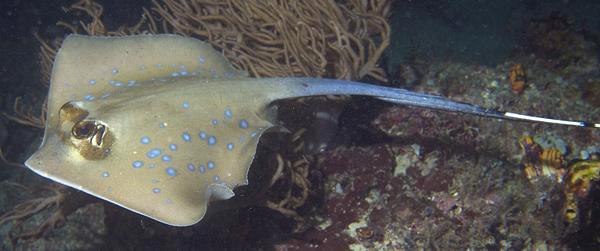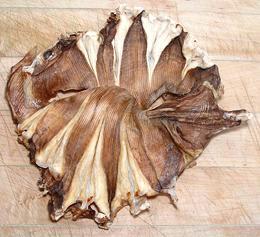 [Order Myliobatiformes; Suborder ]
[Order Myliobatiformes; Suborder ]
Rays are related to the sharks, but developed their winged nature separately from the Skates, so are not as closely related to them as was once thought. Stingrays are the most numerous and diverse of the Rays, and are distinct in having one or more toxic spines, about a third of the way out their long, whip-like tails. Photo of Bluespotted Stingray by Elias Levy, distributed under license Creative Commons Attribution Share-Alike v2.0 Generic.
Rays (order Myliobatiformes) formerly included three Suborders,
but one has been moved. Of the two remaining suborders, Stingrays are
by far the most well known, thornbacks being a very incidental catch from
Japan to Vietnam and from Marin county, California to the tip of Baja
Californi, Mexico.
More on Skates & Rays.
There are about 220 species of Stingray worldwide, divided into 10 families and 29 genera. Many end up as food fish for humans, usually captured as bicatch from other fisheries. Most of them are IUCN Red List NT (Near Threatened), VU (Vulnerable) or EN (Endangered), but some are CE (Critically Endangered).
The Stingray in the photo example above is a Bluespotted Stingray (Neotrygon kuhlii). Blue spots or blue rings seem to be an South Seas code for "I am toxic". The tail spines of this fish are long, sharp, and highly toxic.
This Stingray inhabits a wide region from the east coast of Africa to the islands of the central Pacific. It is most populous on the north coast of Australia and extends north to the southern tip of Japan. It is caught in great quantities in the bottom fisheries, but is not itself a target due to its small size. It is smoked, salted and dried for local markets. IUCN Red List DD (Data deficient).
Buying: I have not found Stingray in the fish markets here in Los Angeles, except the dried form in the photo below.
Subst: Skate wings of similar size are pretty much interchangeable with Stingray wings (the only edible part).
Scales: The skin needs to be peeled off because it's basically shark skin and shark skin is gritty. Shark scales are built more like teeth than like regular fish scales and don't scrape off. and for this reason sharks, skates and rays are not kosher.
Preparation & Cooking: For details see our Skate Wings page. The methods are pretty much the same.
 This form is popular in Vietnam. It can be made with various small
stingrays that live in the great Mekong and Chao Phraya river basins
of Vietnam and Thailand, or in the seas of that region. The photo
specimen was purchased from the frozen food cases of a large Asian
market in Los Angeles (San Gabriel) for 2019 US $7.49 / 14 ounces
(4 sting rays). This form is not fully dried and needs to be kept
frozen.
This form is popular in Vietnam. It can be made with various small
stingrays that live in the great Mekong and Chao Phraya river basins
of Vietnam and Thailand, or in the seas of that region. The photo
specimen was purchased from the frozen food cases of a large Asian
market in Los Angeles (San Gabriel) for 2019 US $7.49 / 14 ounces
(4 sting rays). This form is not fully dried and needs to be kept
frozen.
This form is eaten by roasting it over a gas burner, taking care it
does not burn, and then tearing it into strips which are eaten with a
dip, usually a Tamarind based dip.